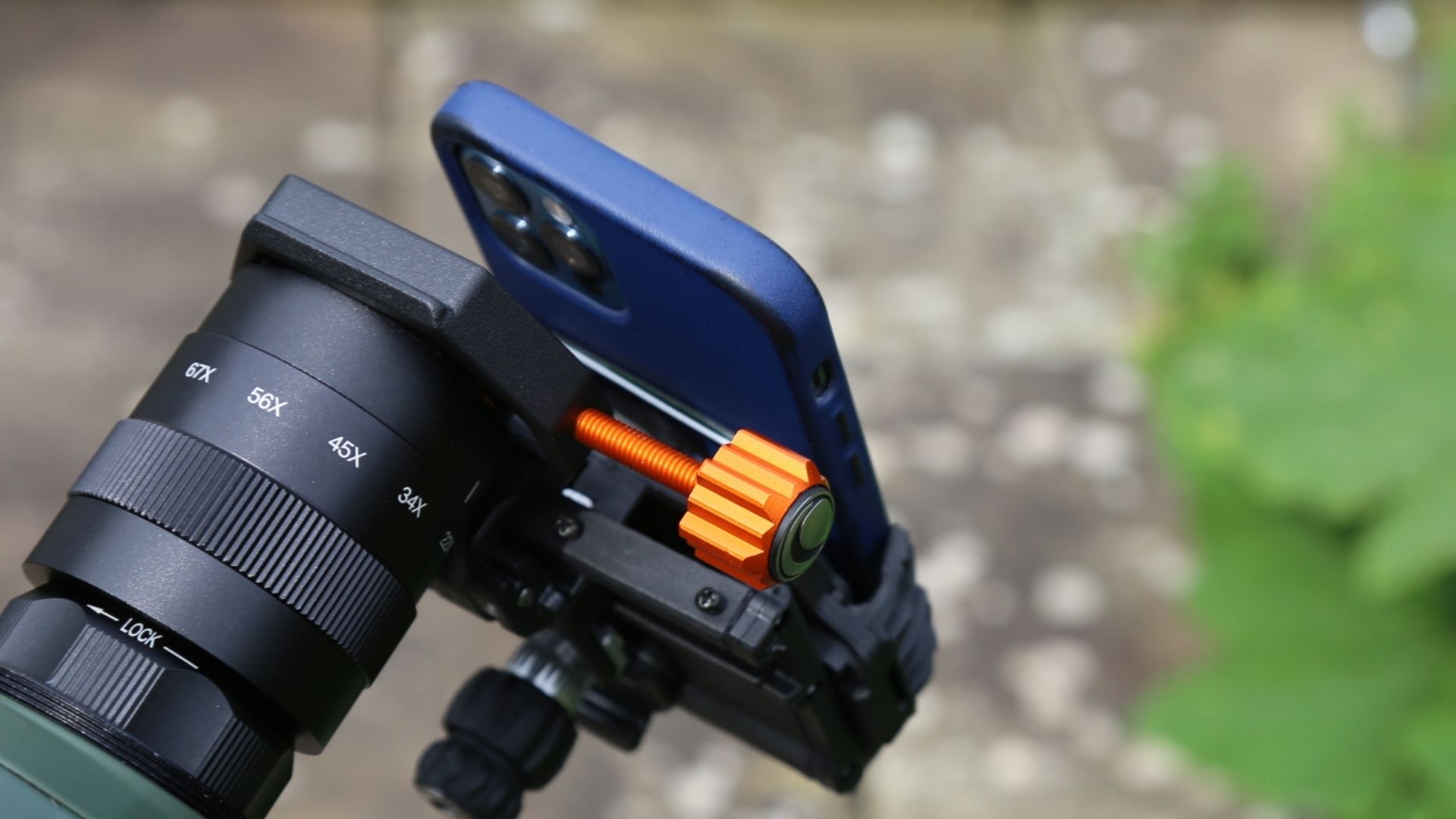Digital Camera World Verdict
Perfect for casual afocal photography, this easy to use adaptor can be clamped on to the eyepiece of a telescope, spotting scope or binoculars, but its success hinges on the eyepiece being used.
Pros
- +
2-axis positioning
- +
No droop
- +
Excellent build quality
- +
Easy to use
Cons
- -
No V axis
- -
Doesn’t fit all eyepieces
- -
Lacks safety lock
- -
Bluetooth remote not necessary
Why you can trust Digital Camera World
Have you ever tried to take a photo through a telescope, a spotting scope, a pair of binoculars or monoculars using your smartphone? It’s not easy, but this digiscoping kit tries to change that. A simple smartphone holder that clamps on to an eyepiece, the Celestron NexGO DX allows the user not only to position a smartphone (or, rather, its camera sensor) in exactly the right position to take a photo using standalone optical devices.
This technique, known as afocal photography or digiscoping, is all about remaining as hands-free as possible. After all, not only is it important to keep a smartphone very stable while attempting to take a photo, but you also need to fix the exposure and focus in a smartphone’s camera. Cue the Celestron NexGO DX.
Specifications
Compatibility: telescopes, binoculars, spotting scopes, monoculars and microscopes
Eyepiece clamp range: 25.4-44.45mm/1.0"-1.75"
Axis: 2
Materials: aluminium frame and polymer body
Dimensions: 196.5x101.6x76.2 mm/7.75”x4”x3”
Weight: 363/12.8oz
Performance
The Celestron NexGO DX makes digiscoping easier by providing, firstly, a simple spring-loaded clip that’s good for smartphones of up to 58-103mm/2.28"4.06" in size (so, most phones, though a small piece of plastic is provided to boost-up anything particularly small).
Secondly, it provides two axes of movement; V (up and down) and X (left and right). Previous incarnations of astronomy-centric brand Celestron’s digiscoping adaptors – chiefly the Celestron NexYV – also present a Y axis (back and forward), but that’s not much missed here. Not only does its lack of a Y axis make the NexGO as simple to use as possible, but it also reduces the chances of it drooping when holding the weight of a smartphone simply by there being less engineering gubbins hanging off the eyepiece and changing the balance.
As well as omitting a Y axis, the NexGO also doesn’t include a safety lock for its guest device, where the NexYV does. We didn’t much miss that either, and at no time during our review did we feel that our smartphone was going to fall out of the clamp.
So why is the Celestron NexGO DX referred to as a ‘kit’? It comes with a Bluetooth remote. That’s it. Rather small and easy to lose, this CR2032 battery-powered thumb-remote does overcome one of the pain-points of afocal astrophotography. Touching the screen of a smartphone to take a photo is to be avoided when focusing on, say, the Moon (which is what we used the NexGO to capture). However, avoiding the inevitable wobble of doing so is actually very easy, the magic words being: “Hey Siri, take a photo.” Almost all smartphone cameras, iOS and Android, include both voice-control and shutter delay options. So the Bluetooth remote probably isn’t required.
The best camera deals, reviews, product advice, and unmissable photography news, direct to your inbox!
There’s also the issue of smartphones with multi-lens arrays, which account for all flagship smartphones these days. Like most smartphone adaptors, the NexGO’s positioning of the camera’s sensor across the eyepiece still requires the user to zoom in on, say, the Moon, to get a full-screen image. That can mean the smartphone swapping to another lens, which means repositioning the smartphone. It’s a pain, but the NexGO does make it relatively easy and quick to reposition.
Here are some sample images shot with the NexGO DX:
Although we found the NexGO enjoyable to use, it does come with limitations, chiefly that it attaches only to eyepieces that are 25.4-44.45mm/1.0"-1.75" in size. That should be fine for most optical devices, but in practice it’s not just about the eyepiece size, but the eye relief barrel it uses (if any). That was the case with a (ironically Celestron-made) spotting scope I tried it with, where the rim of the eyepiece was simply too thick for the NexGO’s hexagonal clamp to fix around. I was eventually able to use it, but only after manually removing both the scope’s eyepiece and the fixing buffer within the NexGO’s hexagonal clamp.
Verdict
The Celestron NexGO is a good adapter to get started with astrophotography. It’s inexpensive and simple to use and will suit most users most of the time. We also liked the way the hexagonal clamp used to fit around a telescope’s eyepiece folds up for easy travel. However, it does come with a few limitations that mean it may not fit the exact piece of optical gear you want to use it for.
Read more:
• Best telescopes for astrophotography
• Best astrophotography gear
• Best binoculars
• Best monoculars
• Best spotting scopes

Jamie has been writing about photography, astronomy, astro-tourism and astrophotography for over 15 years, producing content for Forbes, Space.com, Live Science, Techradar, T3, BBC Wildlife, Science Focus, Sky & Telescope, BBC Sky At Night, South China Morning Post, The Guardian, The Telegraph and Travel+Leisure.
As the editor for When Is The Next Eclipse, he has a wealth of experience, expertise and enthusiasm for astrophotography, from capturing the moon and meteor showers to solar and lunar eclipses.
He also brings a great deal of knowledge on action cameras, 360 cameras, AI cameras, camera backpacks, telescopes, gimbals, tripods and all manner of photography equipment.








